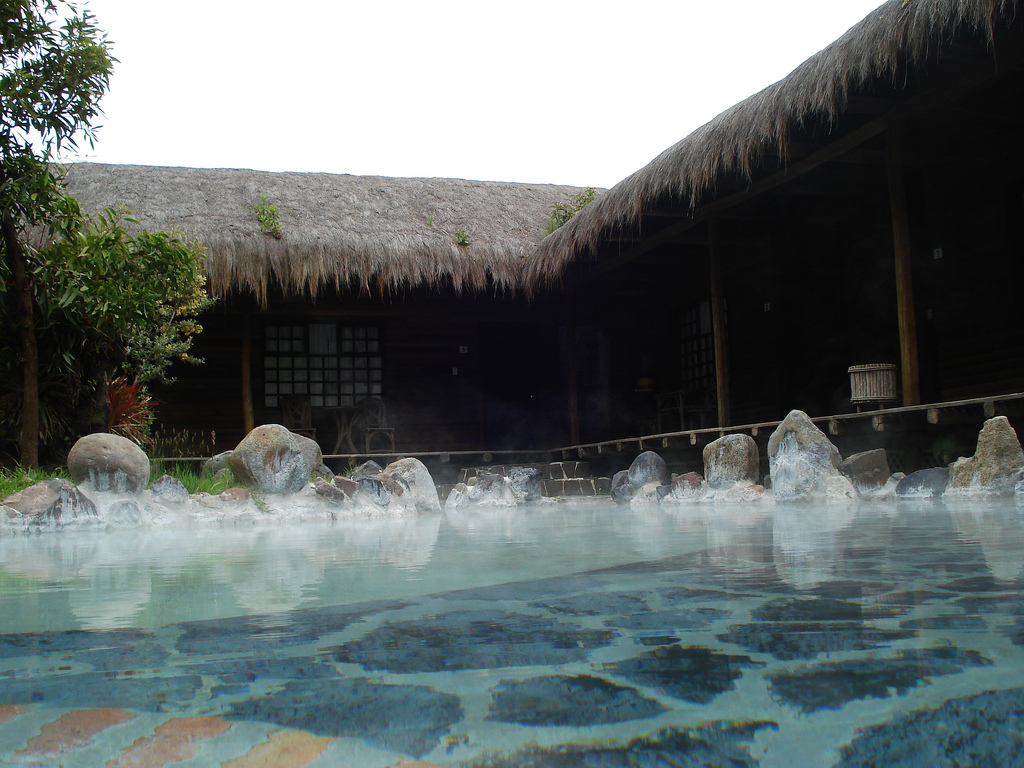
Steam rises off the water at the Hotel Termas de Papallacta. Photo © ximena, licensed Creative Commons Attribution No-Derivatives.
Shortly after the road to Baeza crests the Eastern Cordillera, about 60 kilometers from Quito, it approaches the Papallacta lake district on the northern (left) side. This gorgeous stretch of country, filling the southern tip of the Cayambe-Coca Ecological Reserve, offers plenty of hiking possibilities among moody glacial lakes and crumbling hills that evoke the craggy countryside of Scotland. It’s only a few hours from Quito, and any bus heading toward Tena or Lago Agrio can drop you along the way. Be ready for wet, boggy conditions, particularly June–August. The best time to hike here is October–February. Note that it’s easy to get lost, so take a compass and a map. The IGM Papallacta, Laguna de Mica, and Sincholagua 1:50,000 maps cover the area. At the crest of Papallacta Pass, the statue of the Virgin on the south side of the road marks the start of a great day hike among the lakes.At the crest of Papallacta Pass, the statue of the Virgin on the south side of the road marks the start of a great day hike among the lakes. Head up the dirt road opposite the Virgin toward the antenna-topped hill to the north, stop at the new guard-post house. Pay the $2 entry fee and head up to the “360 hill,” which has a panoramic view of the surrounding páramo. Horses ($6 per hour) can also be rented. From here, hike downhill to the northeast toward the southern end of Laguna Parcacha, then southeast from there toward the park guard station south of Laguna Loreto. A dirt road heads south to the Papallacta hot springs.The rest of the Lake District spreads north from Papallacta, with multiday hikes connecting bordering towns like Pifo and Oyacachi. Laguna Papallacta, the largest lake in the area, lies to the south of hot springs on the Río Papallacta.
Longer hikes in the area, including into the Reserva Ecológica Cayambe-Coca, can be arranged with Fundación Ecológica Rumicocha, which has an office in Papallacta (General Quisquis, tel. 6/232-0637). Guides cost from $15 per day.
Whether you’re on the way to the rainforest, on a hiking trip, or simply want a day trip out of Quito, don’t miss the chance to soak your limbs in the best set of thermal baths in the country. Nestled in a steep Andean valley at a bracing 3,225 meters elevation, the springs attract crowds of Quiteños on weekends but it is relatively quiet during the week. A sign on the left-hand side of the road to Baeza, a few kilometers past the Laguna Papallacta, points up a dirt track. It’s a 20-minute walk from the highway, so if you’re laden with luggage, take a taxi ($2).
At the top of the road, you’ll reach the Termas de Papallacta (Quito tel. 2/256-8989 or Papallacta tel. 6/232-0040). The public section (6 a.m.–9 p.m. daily, $7 pp) is pleasantly landscaped and surrounded by facilities, including changing rooms, bag storage, towel and locker rental, and a pricey café-restaurant. The baths range from paddling-pool to swimming-pool size, and from ice-cold to scalding hot. There are horseback trips available on weekends. The private spa next door (8 a.m.–7 p.m. daily, $18 pp) offers spa pools with water jets and bubble jets. The center also offers massages, a sauna, and other spa treatments.
The Fundación Terra operates an information center on the hill to the right of the baths called the Exploratorio ($2), which introduces visitors to the ecology of the section of the Papallacta River canyon between the baths and the border of the Cayambe-Coca Reserve. Three short walking trails have been developed: You can hike the one-kilometer trail on your own, but the two- and four-kilometer trails require a guide.
Papallacta has a few lodging offerings, ranging from budget to luxury. Most hotels have restaurants attached. In town there are a couple of options at the cheap end of the scale. La Choza de Don Wilson (Quisquis, tel. 6/232- 0627, $15 s, $30 d) is the best of these, with an enclosed hot pool, good views over the valley, and a popular restaurant serving a set menu ($4). Hotel Coturpa (Quisquis, tel. 6/232-0640, $17 s, $30 d, breakfast included) is adequate, but the thermal pools are only filled for tour groups.
On the way to the baths, Hostería Pampa de Papallacta (tel. 6/232-0624, $35 s, $55 d, breakfast included) has been recently refurbished and offers more comfortable guest rooms and its own hot pools. Hostal Antisana (tel. 6/232-0626, $17 s, $34 d) is closer to the baths, but more basic with rather cold guest rooms.
For the best accommodations in town, reserve one of the 36 smart guest rooms or 12 thatched adobe cabins at the Hotel Termas de Papallacta (Quito office: Foch E7-38 at Reina Victoria, tel. 2/256-8989, Papallacta tel. 6/232-0040, $135 s or d, 6-person cabins $192). Prices include access to the hotel’s private baths, and there is a choice of three restaurants (entrées $6–12). The hotel also operates a 250-hectare ranch on the Papallacta River for birding and hiking excursions into the cloud forest.
Papallacta has several buses every hour from Quito’s Quitumbe station (2 hours, $2.50). Take any bus heading to Tena, Lago Agrio, or Coca and ask the driver to let you off either at the junction to the baths or in town. To continue into the Oriente, simply wait on the main highway in town and flag down a bus. To get to the baths from town, take a taxi ($2) if you don’t want to do the 20-minute walk.
Excerpted from the Fifth Edition of Moon Ecuador.